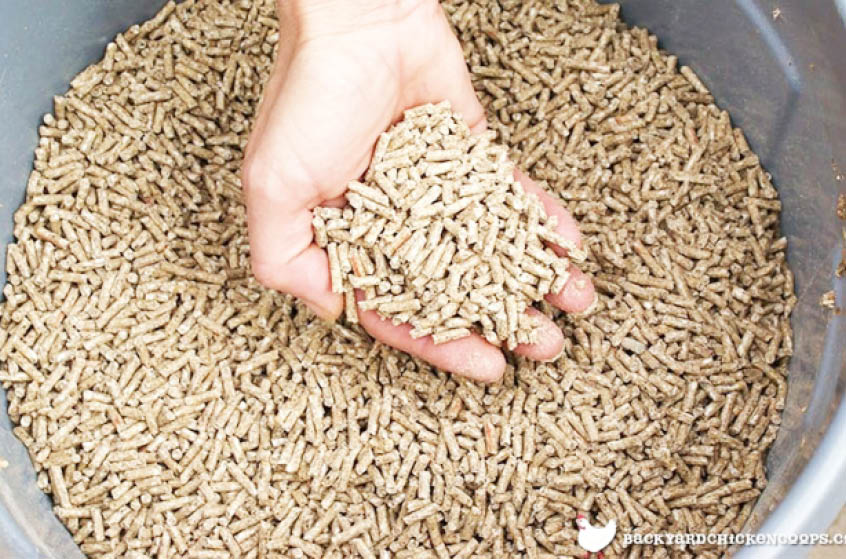If your poultry production is largely on a farm where ample supplies of grain are grown, this publication can and should lead to low-cost, efficient production. Grain in some form may comprise 75 per cent to 90 per cent of a well-balanced poultry ration. Frequently, however, a full grain bin means careless or indifferent feeding because no attempt is made to balance this ration properly. One must include all the essential nutrients in order to obtain a profitable rate of growth or egg production. The poultry raiser who must buy all his feed knows this full well, and in addition he aims to sell only high quality products; otherwise he cannot continue long in business. The purpose of this publication is to encourage the efficient use of feed on farms where poultry and eggs are being produced. It is the poultry keeper’s responsibility to market well-finished birds, and eggs of the best quality, in order to secure maximum returns in relation to feed and other costs.
Feeds
Wheat usually is one of the best grains for poultry feeding, although a proportion of coarse grains in some form should always be included in the ration, along with wheat. In seasons of rust or frost, when wheat is shrunken, more should be ground and fed in mashes and less in the scratch feed. Either hard spring or Durum wheat may be used.
Corn (maize) is a very desirable grain fed whole, cracked or ground. Ripe corn on the cob may be fed to hens and turkeys. Shelled corn may be used with other grains as scratch feed. Corn chop could be included in any of the dry mash rations listed in this circular. The corn, if not thoroughly dried, should be mixed with the other chop in the mash immediately after grinding.
Millet (proso or hog millet), where grown, may be used to good advantage in growing, laying, and fattening rations. Millet may compromise up to one-third of the whole grain fed, and up to one-third of the chop mixture in dry mashes.
By-products of grain (such as wheat middlings, shorts, bran, barley meal, oat flour, oat middlings, and soybeans) have a place in poultry feeding, especially where feed must be bought. They may be higher in price than the whole grain, and if used should be fed for a specific purpose, such bran, shorts or middlings in growing and laying rations, and oat flour, oat middlings, oat feed, or barley meal in fattening rations.
Skim milk and butter milk are excellent for all classes of poultry but especially valuable for young chicks, laying hens and fattening birds. Milk supplies the vitamin riboflavin which is indispensable to high hatching quality in eggs. As a desirable protein supplement, milk undoubtedly heads the list.
“Concentrates” and “Balancers” are especially prepared supplements put up by feed companies. They should be added to home-grown chopped grains in proportions recommended by the manufacturers.
Fish oils (cod liver oil, pilchard oil, etc.) are used in chick rations, in winter laying rations and in rations for producing eggs for hatching, as a source of Vitamins A and D when the supply of green pasture and direct sunshine is limited or lacking. Standard fish oils for poultry should contain 1,250 units or more of Vitamin A, or more of Vitamin D, per gramme. If fed in dry mash the oil should be mixed first with a small quantity of ground wheat.
Rations for growing chickens
Starter rations:
Young chicks require a diet rich in protein and certain vitamins, with a carefully balanced mineral content. Two pounds of chick starter dry mash will feed one chick up to about six weeks of age. After that, in the case of the birds to be reared to maturity, a cheaper ration with increasing amounts of whole grain may be used. Birds to be killed as broilers, however, should be kept on a more concentrated diet to promote the rapid growth essential to profit in broiler raising.
While one may mix chick starter at home, the simplest plan is to purchase 200 pounds of commercial chick starter mash for each 100 chicks. Choose a brand that is flaky or mealy, avoiding the less palatable finely ground mixtures that tend to paste inside the chick’s mouth. The dry mash should be stored in a cool dry place and fed fresh daily.
Start feeding the chicks as soon as they want to eat. Place dry mash on clean egg-case flats (cup type) or on clean cardboard, at several points around the brooder, with possibly a little cracked wheat or chick scratch grain sprinkled over the mash. After two or three days, when all the chicks have learned to eat, place the dry mash in self-feeders. The usual method is to keep dry mash continuously before the birds, though some people prefer to lift the feeders for an hour at a time during each half day.
Provide a constant supply of fresh drinking water in clean chick fountains. Place hard insoluble grit or fine gravel in pans or hoppers separate from the feed. In addition to the dry mash a little cracked wheat may be fed at three weeks, and a little whole wheat after four weeks.
SOURCE: Manitoba

 Join Daily Trust WhatsApp Community For Quick Access To News and Happenings Around You.
Join Daily Trust WhatsApp Community For Quick Access To News and Happenings Around You.


